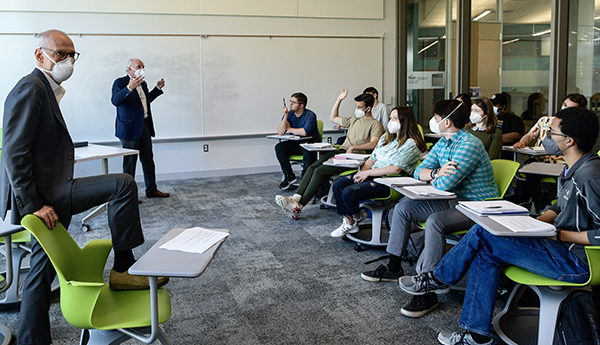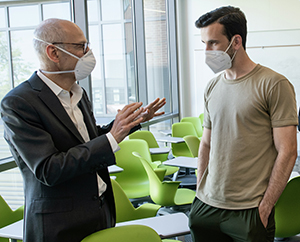In This Story


This story is adapted with permission from Penn Today.
Learning the inner workings of Washington, D.C., typically comes after a long career inside the Beltway, from how politicians manage to reach across the aisle and make successful policy decisions to understanding the role of think tanks and media.
But for a few dozen students at the University of Pennsylvania and George Mason University, that experience was condensed into a single spring course called How Washington Really Works. The innovative class brought the students from Penn and George Mason every Friday to the Penn Biden Center at the base of Capitol Hill in Washington. The semester-long course was co-taught by Penn Vice Provost for Global Initiatives Ezekiel Emanuel and Pulitzer Prize-winning former Washington Post columnist and Mason Robinson Professor Steven Pearlstein.
In a conference room with a full wall of floor-to-ceiling windows facing the U.S. Capitol building, the class looked at eight case studies to explore post-World War II policy debates, political dealing, institutional dynamics, and the personalities, motivations, and ambitions of the people involved in enacting legislation and operating the federal government. (The final class of the semester took place at Mason’s Horizon Hall on the Fairfax Campus while Penn students participated via video.)
Every class involved high-profile Washington insiders as guests who could speak to the topic of the day.
“They've had an opportunity to hear from people at the highest level of government: the former chief of staff, the former majority leader in Congress, the national security adviser to a president, the head of the New York Times Washington bureau,” Emanuel said.
“Tom Donilon was advising Obama on whether to send Navy SEALs in to kill Osama bin Laden and how to weigh that choice. Hearing from someone like that doesn't happen every day for Penn students, or for any student anywhere. Having these speakers week after week is a pretty amazing, insightful experience,” he said.
Case studies included topics such as John F. Kennedy and the Cuban Missile Crisis; Bill Clinton’s Welfare Reform efforts, with Tom Daschle, former Senate Democratic/Majority Leader, as guest speaker; and George Bush, Barack Obama, and the 2009 Auto Bailout, featuring speaker Tim Geithner, former Secretary of Treasury.
Emanuel and Pearlstein, a Robinson Professor of Public Affairs, connected about 12 years ago, when Pearlstein was covering the passage of the Affordable Care Act for the Washington Post, and Emanuel was helping Obama craft the law in his role as health policy advisor. They developed a friendship over the years, and when Pearlstein transitioned into a new role as college professor, they started to talk about possible classes looking at the ways of Washington, Emanuel said.
“Both of us were lamenting how little students understood what really drives things in Washington and how things have changed. So, we hatched a plan to get students to think about civic life in different ways, to help them understand what's going on today in government and how to get things done,” Emanuel said.
Pearlstein said the class differs from a standard political science course in that it treats politics and governing more as an art—or at least a craft—than a science.
“What I hope we can do in this course is cure students of the deep cynicism, and a lot of their ideologically driven assumptions, that they bring to political and policy issues,” Pearlstein says. “They should come away with a lot more nuanced and sophisticated view of why politicians and institutions behave the way they do, why things happen and why they don’t.”
This spring was the inaugural launch of the How Washington Really Works course. Pearlstein said the course will be offered again in fall 2023.
Emanuel and Pearlstein alternated weeks of teaching, with the first half of the class a lecture and discussion and the second half of the 3.5-hour session devoted to the guest speaker.
On the day they discussed the Affordable Care Act, after Emanuel shared his first-hand knowledge, guest speaker Liz Fowler gave her insider view on helping write the ACA and her efforts to achieve bipartisanship. At the time, Fowler was chief health counsel to former Senate Finance Committee Chairman Max Baucus, the Democrat from Montana who played an influential role in the debate on health care reform.
In the final weeks of the course, students worked in groups of politically like-minded colleagues to come up with comprehensive, politically realistic policy proposals to either regulate big tech, reduce poverty, or secure the promise of racial justice.
Sam Brause, a Penn senior computer science major, took the class because it was his final semester at Penn, and he wanted to take something totally different than his computer science courses.
Brause says taking classes with Mason students offered a valuable perspective and he appreciated the rapport the professors had with one another. And taking the class in Washington itself was particularly beneficial, Brause said.
Molly Reed, a senior at Mason Schar School of Policy and Government majoring in government and international politics, said collaborating with Penn students has been the highlight of the class.
“Also, getting the chance to learn from two renowned experts in the heart of D.C. was not something I wanted to pass up,” she said.
And being so close to the Capitol building was awe-inspiring, the Dallas, Texas, native said.
“Most of us have dreamed of working in politics for years. You can imagine how inspiring it is to be learning at the foot of where our nations’ decisions are being made,” she said. “It so happened that the day we were discussing Clarence Thomas’ Supreme Court nomination was the day Justice Ketanji Brown Jackson was nominated. Watching history happen across the street from our class is a memory none of us will forget.”
Schar School first-year student Pearl Matibe, a government and international politics major originally from Zimbabwe, said she took the class hoping to get a sense of the cultural, political, and economic dimensions that shape what happens on Capitol Hill. The class didn’t disappoint, she said, from the guest speakers to having a professor from another university to the location itself.
“While a university campus lecture hall has a similar look and feel in many cities across America, there is no other place on earth where the Capitol building—a distinct symbol to the world—is within view throughout class,” she said. “You can pick any class seat, and you have a panoramic view of the Capitol, and from the rooftop, Capitol Hill.”
How Washington Really Works is made possible by the Stavros Niarchos Foundation (SNF) Paideia Program, which supports classes at Penn that aim to examine the theory and practice of dialogue across differences.
